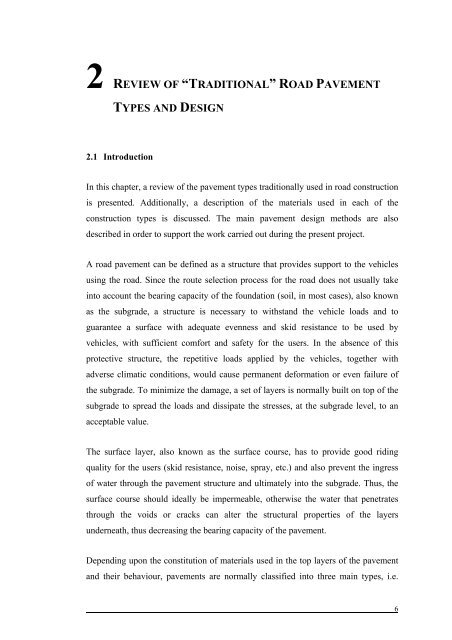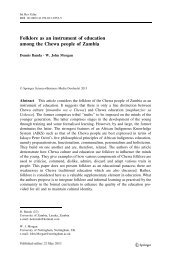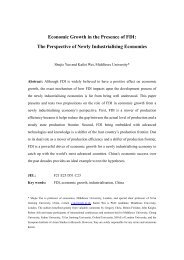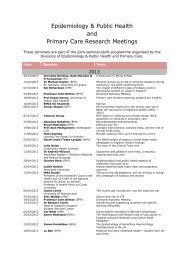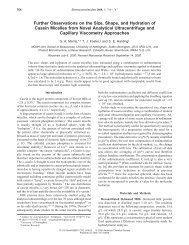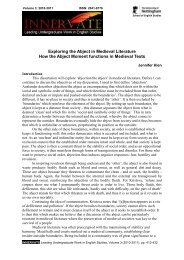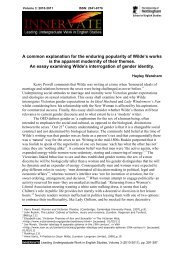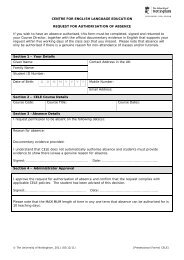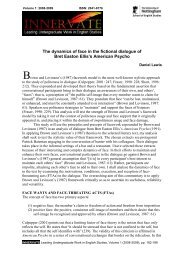- Page 1 and 2: GROUTED MACADAM - MATERIAL CHARACTE
- Page 3 and 4: ACKNOWLEDGEMENTS The present projec
- Page 5 and 6: LIST OF CONTENTS Abstract i Acknowl
- Page 7 and 8: List of Contents 6 Grouted Macadams
- Page 9 and 10: LIST OF FIGURES List of Contents Fi
- Page 11 and 12: List of Contents Figure 4.2 - Grout
- Page 13 and 14: List of Contents Figure 6.32 - Crac
- Page 15 and 16: List of Contents Figure 8.12 - Infl
- Page 17 and 18: LIST OF TABLES List of Contents Tab
- Page 19 and 20: 1 INTRODUCTION 1.1 Background Road
- Page 21 and 22: Chapter 1 Introduction These facts
- Page 23: Chapter 1 Introduction is discussed
- Page 27 and 28: Chapter 2 Review of “Traditional
- Page 29 and 30: Chapter 2 Review of “Traditional
- Page 31 and 32: Chapter 2 Review of “Traditional
- Page 33 and 34: Chapter 2 Review of “Traditional
- Page 35 and 36: Chapter 2 Review of “Traditional
- Page 37 and 38: Chapter 2 Review of “Traditional
- Page 39 and 40: Chapter 2 Review of “Traditional
- Page 41 and 42: Chapter 2 Review of “Traditional
- Page 43 and 44: Chapter 2 Review of “Traditional
- Page 45 and 46: Chapter 2 Review of “Traditional
- Page 47 and 48: Chapter 2 Review of “Traditional
- Page 49 and 50: Chapter 2 Review of “Traditional
- Page 51 and 52: Chapter 2 Review of “Traditional
- Page 53 and 54: Chapter 2 Review of “Traditional
- Page 55 and 56: Chapter 2 Review of “Traditional
- Page 57 and 58: 3 REVIEW OF GROUTED MACADAMS 3.1 In
- Page 59 and 60: Chapter 3 Review of Grouted Macadam
- Page 61 and 62: Chapter 3 Review of Grouted Macadam
- Page 63 and 64: Chapter 3 Review of Grouted Macadam
- Page 65 and 66: Chapter 3 Review of Grouted Macadam
- Page 67 and 68: Chapter 3 Review of Grouted Macadam
- Page 69 and 70: Chapter 3 Review of Grouted Macadam
- Page 71 and 72: Chapter 3 Review of Grouted Macadam
- Page 73 and 74: Chapter 3 Review of Grouted Macadam
- Page 75 and 76:
Chapter 3 Review of Grouted Macadam
- Page 77 and 78:
Chapter 3 Review of Grouted Macadam
- Page 79 and 80:
Chapter 3 Review of Grouted Macadam
- Page 81 and 82:
Chapter 3 Review of Grouted Macadam
- Page 83 and 84:
Chapter 3 Review of Grouted Macadam
- Page 85 and 86:
Chapter 3 Review of Grouted Macadam
- Page 87 and 88:
4 DEVELOPMENT OF FOUR-POINT BENDING
- Page 89 and 90:
Chapter 4 Development of Four-Point
- Page 91 and 92:
Chapter 4 Development of Four-Point
- Page 93 and 94:
Chapter 4 Development of Four-Point
- Page 95 and 96:
Chapter 4 Development of Four-Point
- Page 97 and 98:
Chapter 4 Development of Four-Point
- Page 99 and 100:
Chapter 4 Development of Four-Point
- Page 101 and 102:
Chapter 4 Development of Four-Point
- Page 103 and 104:
5 BASIC CHARACTERISATION OF THE MAT
- Page 105 and 106:
Chapter 5 Basic Characterisation of
- Page 107 and 108:
Chapter 5 Basic Characterisation of
- Page 109 and 110:
Chapter 5 Basic Characterisation of
- Page 111 and 112:
Chapter 5 Basic Characterisation of
- Page 113 and 114:
Chapter 5 Basic Characterisation of
- Page 115 and 116:
Chapter 5 Basic Characterisation of
- Page 117 and 118:
Chapter 5 Basic Characterisation of
- Page 119 and 120:
Chapter 5 Basic Characterisation of
- Page 121 and 122:
Chapter 5 Basic Characterisation of
- Page 123 and 124:
Chapter 5 Basic Characterisation of
- Page 125 and 126:
Chapter 5 Basic Characterisation of
- Page 127 and 128:
Chapter 5 Basic Characterisation of
- Page 129 and 130:
6 GROUTED MACADAMS MIX DESIGN STUDY
- Page 131 and 132:
Chapter 6 Grouted Macadams Mix Desi
- Page 133 and 134:
Chapter 6 Grouted Macadams Mix Desi
- Page 135 and 136:
Chapter 6 Grouted Macadams Mix Desi
- Page 137 and 138:
Chapter 6 Grouted Macadams Mix Desi
- Page 139 and 140:
Chapter 6 Grouted Macadams Mix Desi
- Page 141 and 142:
Chapter 6 Grouted Macadams Mix Desi
- Page 143 and 144:
Chapter 6 Grouted Macadams Mix Desi
- Page 145 and 146:
Chapter 6 Grouted Macadams Mix Desi
- Page 147 and 148:
Chapter 6 Grouted Macadams Mix Desi
- Page 149 and 150:
Chapter 6 Grouted Macadams Mix Desi
- Page 151 and 152:
Chapter 6 Grouted Macadams Mix Desi
- Page 153 and 154:
Chapter 6 Grouted Macadams Mix Desi
- Page 155 and 156:
Chapter 6 Grouted Macadams Mix Desi
- Page 157 and 158:
Chapter 6 Grouted Macadams Mix Desi
- Page 159 and 160:
Chapter 6 Grouted Macadams Mix Desi
- Page 161 and 162:
Chapter 6 Grouted Macadams Mix Desi
- Page 163 and 164:
7 DETERIORATION OF HALF-SCALE PAVEM
- Page 165 and 166:
Chapter 7 Deterioration of Half-Sca
- Page 167 and 168:
Chapter 7 Deterioration of Half-Sca
- Page 169 and 170:
Chapter 7 Deterioration of Half-Sca
- Page 171 and 172:
Chapter 7 Deterioration of Half-Sca
- Page 173 and 174:
Chapter 7 Deterioration of Half-Sca
- Page 175 and 176:
Chapter 7 Deterioration of Half-Sca
- Page 177 and 178:
Chapter 7 Deterioration of Half-Sca
- Page 179 and 180:
Chapter 7 Deterioration of Half-Sca
- Page 181 and 182:
Chapter 7 Deterioration of Half-Sca
- Page 183 and 184:
Chapter 7 Deterioration of Half-Sca
- Page 185 and 186:
Chapter 7 Deterioration of Half-Sca
- Page 187 and 188:
Chapter 7 Deterioration of Half-Sca
- Page 189 and 190:
Chapter 7 Deterioration of Half-Sca
- Page 191 and 192:
Chapter 7 Deterioration of Half-Sca
- Page 193 and 194:
Chapter 7 Deterioration of Half-Sca
- Page 195 and 196:
Chapter 7 Deterioration of Half-Sca
- Page 197 and 198:
Chapter 7 Deterioration of Half-Sca
- Page 199 and 200:
Chapter 7 Deterioration of Half-Sca
- Page 201 and 202:
8 DEVELOPMENT OF DESIGN METHOD FOR
- Page 203 and 204:
Chapter 8 Development of Design Met
- Page 205 and 206:
Chapter 8 Development of Design Met
- Page 207 and 208:
Chapter 8 Development of Design Met
- Page 209 and 210:
Chapter 8 Development of Design Met
- Page 211 and 212:
Chapter 8 Development of Design Met
- Page 213 and 214:
Chapter 8 Development of Design Met
- Page 215 and 216:
Chapter 8 Development of Design Met
- Page 217 and 218:
Chapter 8 Development of Design Met
- Page 219 and 220:
Chapter 8 Development of Design Met
- Page 221 and 222:
Chapter 8 Development of Design Met
- Page 223 and 224:
Chapter 8 Development of Design Met
- Page 225 and 226:
Chapter 8 Development of Design Met
- Page 227 and 228:
Chapter 8 Development of Design Met
- Page 229 and 230:
Chapter 8 Development of Design Met
- Page 231 and 232:
Chapter 8 Development of Design Met
- Page 233 and 234:
Chapter 8 Development of Design Met
- Page 235 and 236:
9 CONCLUSIONS AND RECOMMENDATIONS I
- Page 237 and 238:
Chapter 9 Conclusions and Recommend
- Page 239 and 240:
Chapter 9 Conclusions and Recommend
- Page 241 and 242:
Chapter 9 Conclusions and Recommend
- Page 243 and 244:
Chapter 9 Conclusions and Recommend
- Page 245 and 246:
References Brown, S. F. and Brodric
- Page 247 and 248:
References Di Benedetto, H., De La
- Page 249 and 250:
References Osman, S. A., (2004). Th
- Page 251 and 252:
References van de Ven, M. F. C. and
- Page 253:
APPENDICES Appendix A: Engineering
- Page 258 and 259:
Stiffness (MPa) 25000 20000 15000 1
- Page 260 and 261:
Stiffness (MPa) 12000 11000 10000 9
- Page 262 and 263:
Stiffness (MPa) 10000 9500 9000 850
- Page 264 and 265:
Stiffness (MPa) 8500 8000 7500 7000
- Page 266 and 267:
Stiffness (MPa) 10000 9000 8000 700
- Page 268 and 269:
Fatigue life of the studied mixture
- Page 270 and 271:
Mixture Specimen Slab 05-0296 PTF -
- Page 272:
Stiffness Modulus of DBM 50 and sta


